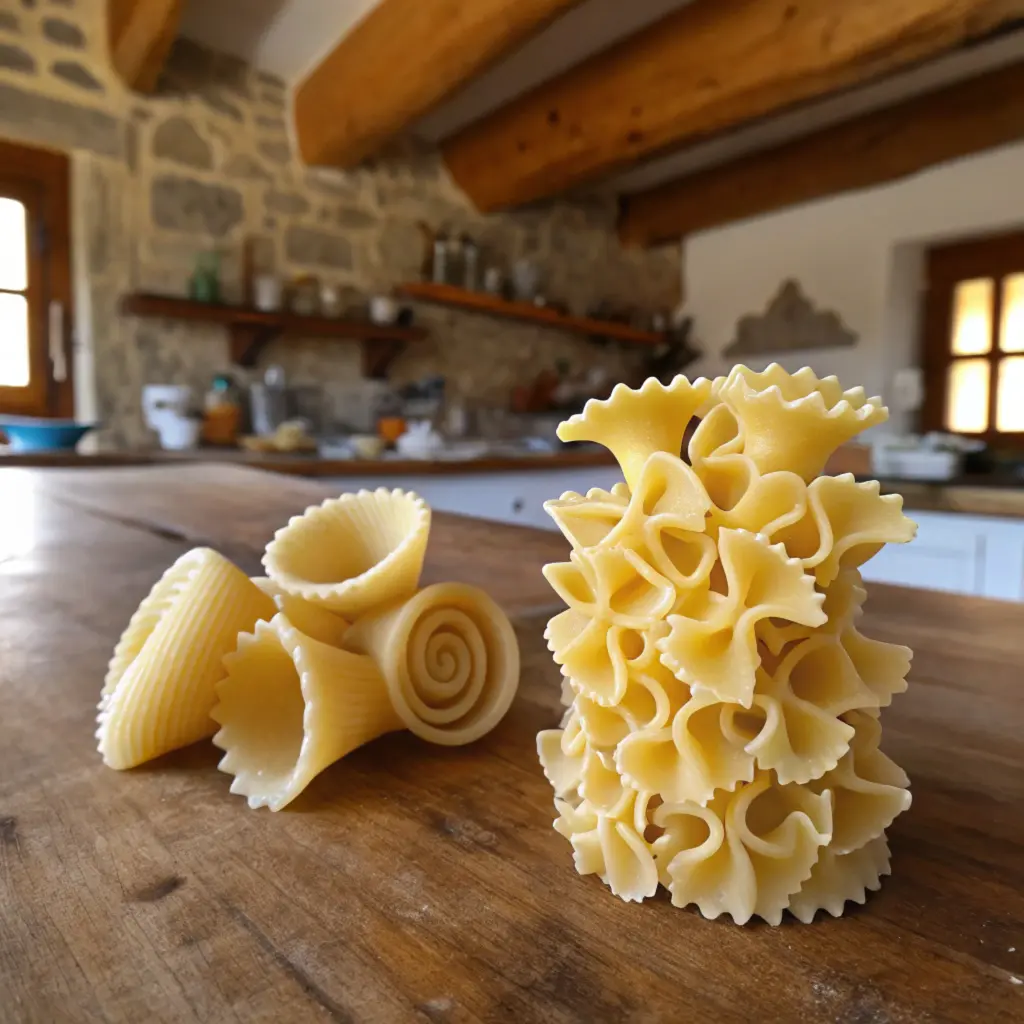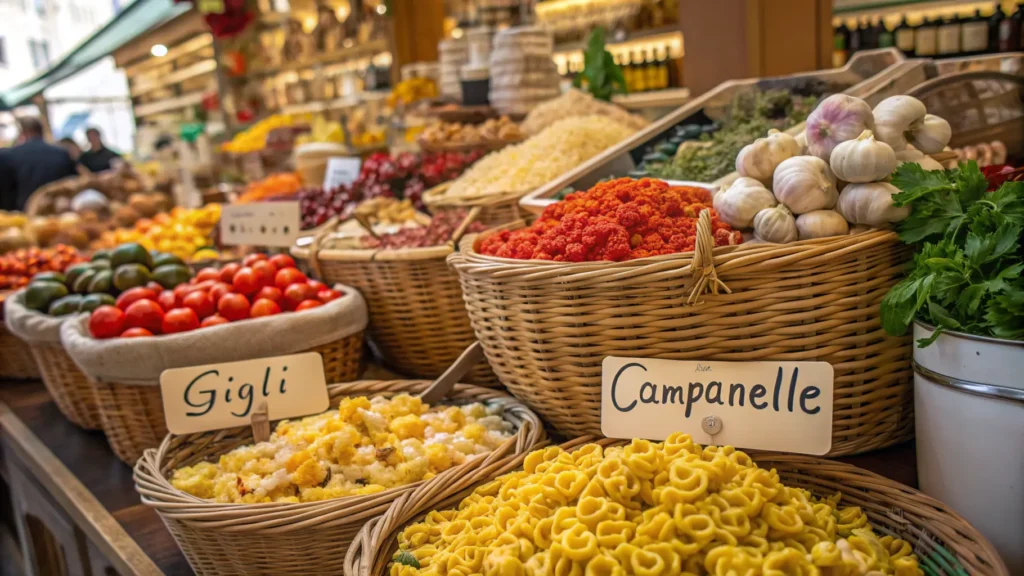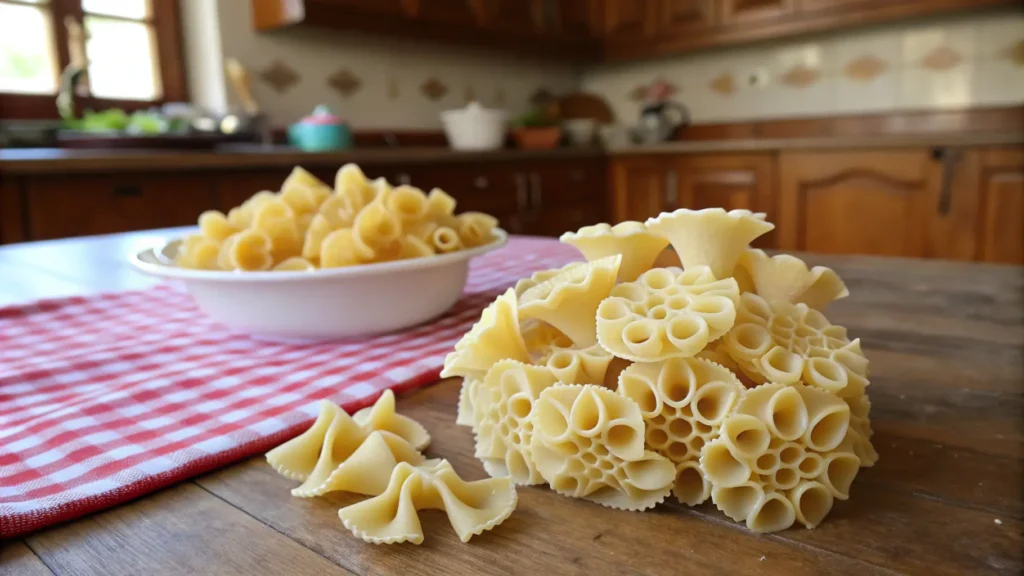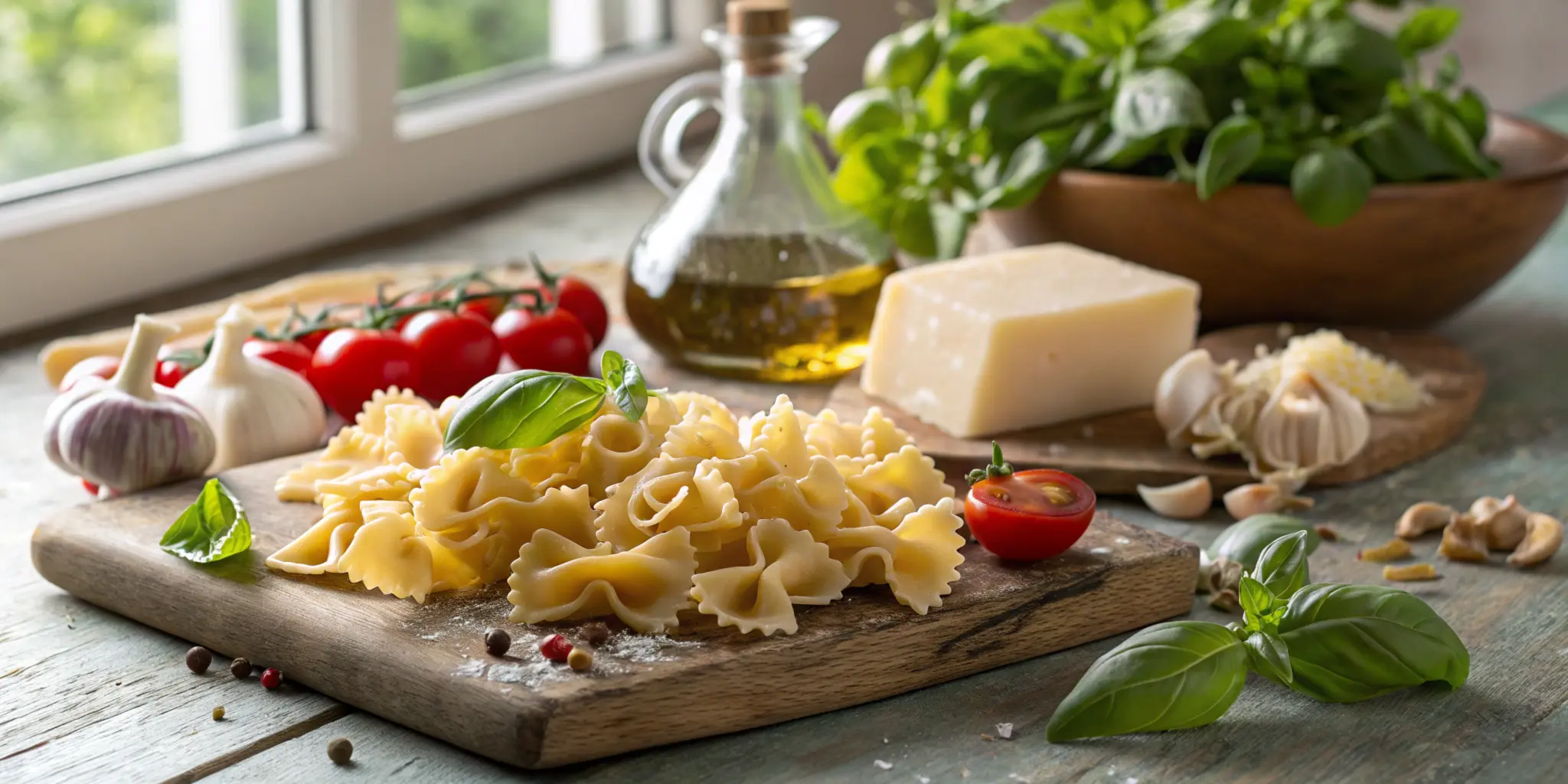Pasta is one of Italy’s greatest culinary treasures, with countless shapes and sizes gracing plates worldwide. Each type serves a specific purpose, bringing its unique flair to a dish. Among the more distinct and lesser-known pasta shapes are Gigli and Campanelle. While both may seem similar at first glance, they have striking differences in design, usage, and history that make them stand out. In this article, we’ll explore these unique pasta shapes, their origins, and the best ways to prepare and enjoy them. Let’s dive into the heart of Italian cuisine!
For a full guide to campanelle pasta, including its history, popular recipes, and expert cooking tips, check out our complete guide here: Campanelle Pasta: A Complete Guide to History, Recipes, and Cooking Tips.
Origins and History of Gigli and Campanelle
Historical Background of Gigli
Gigli, which means “lilies” in Italian, is a pasta shape inspired by the elegance of the lily flower. With its frilled, trumpet-like design, it is a testament to Italy’s artistic culinary traditions. This pasta is deeply rooted in Tuscany, a region celebrated for its rolling hills, vineyards, and hearty food culture. Traditionally, it was handmade by artisans who perfected each petal-like fold, showcasing the care that goes into crafting authentic Italian pasta.
Historical Background of Campanelle
On the other hand, Campanelle, meaning “little bell” in Italian, boasts a playful, bell-shaped structure with fluted edges. Its roots trace back to Southern Italy, particularly Sicily, where vibrant dishes and bold flavors dominate the cuisine. Historically, Campanelle was crafted for recipes that could carry thick, chunky sauces, ensuring every bite was full of flavor.
Cultural Significance in Italian Cuisine
Both Gigli and Campanelle hold their place in Italy’s diverse food culture. Gigli is often associated with festive occasions and traditional Tuscan recipes, while Campanelle’s versatility has earned it a spot in contemporary kitchens worldwide. Whether used in light olive oil sauces or hearty ragù, these shapes embody the regional pride of their origins.
Etymology of Gigli and Campanelle
Meaning of “Gigli” in Italian
The word Gigli translates directly to “lilies” in Italian, a flower often associated with purity and elegance. The pasta’s design, with its fluted edges and flared, trumpet-like structure, mimics the delicate petals of a blooming lily. This poetic naming reflects the Italian tradition of connecting food with nature and artistry. Its name alone evokes images of beauty and sophistication, hinting at its Tuscan origins.
Meaning of “Campanelle” in Italian
Campanelle, on the other hand, means “little bell” in Italian. Its name is a playful nod to its bell-like shape, complete with ruffled edges that resemble the flared rim of a traditional bell. This charming name adds a whimsical touch to the pasta, making it a favorite for both its appearance and culinary versatility. Its meaning aligns perfectly with its Southern Italian roots, where food often carries a sense of joy and celebration.
Shape and Design of Gigli and Campanelle
Detailed Description of Gigli’s Shape
Gigli pasta is an intricate work of culinary art. Shaped like a delicate lily flower, it features a conical base that flares outward into softly ruffled edges. This unique structure makes it ideal for holding lighter, oil-based sauces or creamy dressings, as the fluted petals help trap the flavors in every fold. Its elegant design is not only functional but also visually striking, making it a popular choice for sophisticated presentations.
Detailed Description of Campanelle’s Shape
Campanelle, often referred to as “little bells,” boasts a playful yet functional design. Its main body is shaped like a cone, similar to Gigli, but with a more defined bell structure. The edges are flared and ruffled, mimicking the appearance of a blooming flower or a ringing bell. This pasta is excellent for hearty sauces or chunky fillings like vegetables and meat, as its shape traps ingredients in its hollow center and along its folds.
Visual Differences Between the Two
While Gigli and Campanelle share some similarities in their floral-inspired designs, they are distinct in several ways. Gigli has a softer, more petal-like appearance with an overall daintier structure. In contrast, Campanelle is sturdier and more pronounced, with a more defined cone and bell shape. Gigli is often more delicate, suitable for lighter dishes, whereas Campanelle’s robust design pairs well with heavier, thicker sauces.

Production Methods of Gigli and Campanelle
Traditional Methods of Making Gigli
Skilled artisans traditionally handcrafted Gigli pasta using durum wheat semolina and water, rolling and shaping it with minimal machinery. They flattened the dough, cut it into squares, and carefully twisted each piece to form the iconic conical shape with ruffled edges. This labor-intensive process required precision, as artisans folded each piece delicately to resemble a lily. In Tuscany, families passed down the preparation of Gigli through generations, reflecting the region’s passion for preserving its culinary heritage.
Traditional Methods of Making Campanelle
Cooks relied on hands-on craftsmanship to make Campanelle pasta. They prepared the dough using semolina flour and water, shaping it into small cones and pinching the edges to create the bell-like structure. In southern Italy, where this pasta originated, artisans often used traditional tools like wooden molds and rolling pins. They focused on crafting shapes that cradled robust sauces, a hallmark of the region’s hearty cuisine.
Modern Manufacturing Processes
Today, both Gigli and Campanelle are primarily mass-produced using industrial methods to meet global demand. Pasta dough is extruded through bronze or Teflon dies, creating the desired shapes with consistent quality. Bronze dies produce a rougher texture, ideal for holding sauce, while Teflon dies create a smoother finish. Advances in automation have streamlined production, but some artisan brands still honor traditional methods to maintain authenticity.
Culinary Uses of Gigli and Campanelle
Common Dishes Featuring Gigli
Tuscan recipes often feature Gigli to highlight its delicate shape. Cooks use it in dishes like Gigli alla Fiorentina, pairing it with creamy white sauces, sautéed vegetables, or simple olive oil and garlic. Its ruffled edges hold light sauces effectively, making it a favorite for showcasing subtle flavors.
Common Dishes Featuring Campanelle
Campanelle, with its robust shape, is the star of hearty recipes like Campanelle alla Norma, a Sicilian classic featuring eggplant, tomatoes, and ricotta salata. It also pairs excellently with thick meat sauces, stews, and baked pasta dishes. Its hollow center and flared edges make it perfect for capturing rich, chunky ingredients.
Sauce Pairings for Each Pasta Type
For Gigli, lighter sauces such as garlic butter, pesto, or creamy Alfredo are ideal. These sauces enhance the pasta’s elegant design without overwhelming it. Meanwhile, Campanelle shines with bolder, thicker sauces like ragù, marinara, or creamy cheese-based sauces. Its sturdy structure ensures that every bite is bursting with flavor.

Regional Variations of Gigli and Campanelle
Gigli in Tuscan Cuisine
Tuscany celebrates Gigli as a pasta deeply connected to the region’s heritage, with its name and shape reflecting the lily, Florence’s symbol. Tuscan cooks often pair Gigli with simple yet flavorful sauces that highlight the fresh, local ingredients’ natural taste. Dishes like Gigli with Pecorino Toscano and black pepper (a twist on cacio e pepe) or Gigli tossed with sautéed zucchini and a splash of lemon are common. These recipes emphasize the light, refreshing qualities of Gigli, aligning with the region’s emphasis on high-quality produce and rustic charm.
Campanelle in Sicilian Cuisine
In Sicily, Campanelle’s bell-like shape complements the island’s bold and vibrant flavors. A quintessential dish, Campanelle alla Norma, combines this pasta with eggplant, fresh tomatoes, and ricotta salata, capturing the essence of Sicilian cuisine. Another regional specialty is Campanelle with sardines, pine nuts, and fennel, showcasing the island’s reliance on seafood and Mediterranean ingredients. Its hearty design ensures that it pairs well with these rich, chunky sauces, embodying the robust culinary traditions of Sicily.
Other Regional Adaptations
Chefs across Italy and internationally embrace both Gigli and Campanelle, adapting them to regional and global tastes. In northern Italy, chefs often feature Gigli in creamy mushroom sauces, while southern recipes highlight Campanelle in spicy arrabbiata dishes. Around the world, cooks use these pastas creatively, adding Gigli to cold pasta salads or baking Campanelle with cheese and vegetables, blending tradition with modern culinary trends.
Nutritional Comparison of Gigli and Campanelle
Caloric Content
Both Gigli and Campanelle are made primarily from durum wheat semolina, giving them a similar caloric profile. On average, a 100-gram serving of either pasta contains approximately 350–370 calories, depending on the brand and specific preparation. These calories come primarily from carbohydrates, which provide the energy needed for daily activities.
Macronutrient Breakdown
In terms of macronutrients, both pastas are composed of approximately 70–75 grams of carbohydrates per 100 grams, making them a great source of energy. They also contain about 13 grams of protein, essential for muscle repair and growth. Fats are minimal, typically under 2 grams per serving, as semolina is naturally low in fat. If whole wheat variants are used, the fiber content increases, promoting better digestion and satiety.
Presence of Vitamins and Minerals
Gigli and Campanelle also provide a modest amount of vitamins and minerals, particularly B vitamins like niacin and folate, which support metabolism and red blood cell production. They’re rich in iron, a critical component for oxygen transport in the body, and magnesium, which aids in muscle function. Whole-grain versions further boost their nutritional profile, offering more fiber, vitamin E, and trace minerals.
Both Gigli and Campanelle are made from durum wheat semolina, offering a similar nutritional profile. For a detailed look at the unique qualities and nutritional facts of Gigli pasta, you can explore this comprehensive guide on pasta shapes.
Cooking Techniques for Gigli and Campanelle
Optimal Boiling Times for Gigli
Gigli pasta, due to its delicate, petal-like structure, typically requires 8–10 minutes to cook to an al dente texture. Cooking times may vary depending on whether it’s handmade or store-bought, so always check the package instructions. Handmade Gigli, being slightly thicker, might take an extra minute to achieve the perfect bite.
Optimal Boiling Times for Campanelle
Campanelle’s robust and sturdy design makes it slightly more forgiving during cooking. Its optimal boiling time is around 10–12 minutes, again depending on whether it’s fresh or dried. Its bell-like shape can hold its texture well, even if cooked a little longer, which makes it a favorite for novice cooks.
Tips for Preventing Overcooking
To prevent overcooking, always use a large pot of boiling salted water to ensure even cooking. Stir occasionally to avoid sticking, especially for Gigli, as its petals can easily clump together. Taste the pasta a minute or two before the recommended time to ensure it’s al dente. Once cooked, drain it immediately and toss it with sauce to stop the cooking process and preserve its shape. Using ice water for shocking is unnecessary unless preparing a pasta salad, which helps maintain its firmness.
Availability and Popularity in the Gigli vs. Campanelle Comparison
Prevalence in Italian Markets for Pasta Shape Differences
In Italy, Gigli and Campanelle are widely available, especially in their regions of origin, Tuscany and Sicily. Artisans often craft these pastas using traditional methods, and you can find them in local markets packaged in rustic bags or boxes that reflect their regional pride. Many well-known Italian brands offer authentic versions of these shapes, ensuring that Gigli and Campanelle remain staples in Italian cuisine.
Availability in International Markets for Gigli and Campanelle Comparison
Internationally, the appeal of these pasta shapes has grown significantly. Gourmet stores and large supermarkets now carry Gigli and Campanelle, with brands like Barilla and De Cecco including Campanelle in their selections. Specialty labels often feature Gigli, catering to pasta enthusiasts seeking unique shapes. Additionally, online retailers have made both pastas more accessible to a global audience.
Popularity in Contemporary Recipes Featuring Pasta Varieties Explained
Gigli and Campanelle have found a special place in modern recipes, gaining attention on food blogs and social media platforms. Their aesthetic appeal and versatility make them favorites for chefs and home cooks alike. Gigli often stars in lighter dishes or cold pasta salads, while Campanelle’s robust design makes it ideal for baked recipes or thick sauces. Both shapes continue to rise in popularity as cooks worldwide seek visually striking and functional pasta varieties.

Substitutes and Alternatives in the Gigli and Campanelle Comparison
Suitable Substitutes for Gigli in the Pasta Shape Differences
If Gigli pasta is unavailable, other short, decorative pastas like Farfalle (bow-tie pasta) or Fusilli can serve as excellent substitutes. These alternatives also feature grooves and folds that effectively capture sauces, making them suitable for lighter, creamy sauces. Another strong option is Pipe Rigate, which has a tubular form and ridges, offering a similar ability to hold delicate flavors.
Suitable Substitutes for Campanelle in Italian Pasta Comparison
For Campanelle, sturdy pasta shapes like Cavatappi, Conchiglie (shells), or Radiatori are fantastic options. These varieties are robust and can handle chunky, hearty sauces effectively. In baked dishes, Ziti or Rigatoni may also work well, though they lack the fluted edges that define Campanelle’s bell-like texture and make it unique.
How Substitutes Impact Pasta Varieties Explained
While substitutes can mimic the functionality of Gigli and Campanelle, they may affect a dish’s presentation and experience. Gigli’s elegant, petal-like design adds sophistication that Farfalle or Fusilli might not replicate. Similarly, Campanelle’s ability to cradle chunky ingredients in its hollow center could be compromised when using simpler shapes like Ziti. Although the substitutes may not perfectly replicate the originals’ unique charm, consistent sauces and seasonings can maintain the dish’s flavor profile.
Recipes Highlighting Differences Between Gigli and Campanelle
Recipe: Gigli with Tuscan Meat Sauce
Ingredients:
- 250g Gigli pasta
- 500g ground beef
- 1 onion, finely chopped
- 2 garlic cloves, minced
- 400g canned tomatoes
- 1 tbsp olive oil
- Salt, pepper, and dried oregano to taste
- Fresh basil and grated Parmesan for garnish
Instructions:
- Cook the Gigli pasta in salted boiling water until al dente, then drain.
- Heat olive oil in a skillet, sauté the onion and garlic until fragrant.
- Add the ground beef and cook until browned.
- Stir in the canned tomatoes, oregano, salt, and pepper. Simmer for 15 minutes.
- Toss the cooked Gigli in the meat sauce, ensuring each piece is coated.
- Garnish with fresh basil and Parmesan before serving.
This dish highlights Gigli’s ability to hold delicate, flavorful sauces in its folds, offering a comforting and hearty meal.
Recipe: Campanelle with Sicilian Pesto
Ingredients:
- 250g Campanelle pasta
- 1 cup cherry tomatoes
- 1 cup basil leaves
- 1/4 cup almonds or pine nuts
- 2 garlic cloves
- 1/4 cup olive oil
- Salt and pepper to taste
- Ricotta salata for topping
Instructions:
- Cook the Campanelle in salted boiling water until al dente, then drain.
- In a food processor, blend basil, garlic, almonds, olive oil, salt, and pepper until smooth.
- Toss the cooked pasta with the pesto, ensuring the sauce fills its hollow centers and fluted edges.
- Slice cherry tomatoes in half and stir them into the pasta.
- Top with grated Ricotta Salata and serve warm.
Campanelle’s sturdy, bell-like shape holds the thick Sicilian pesto beautifully, delivering bursts of flavor in every bite.
Frequently Asked Questions (FAQs)
Are Gigli and Campanelle the same?
No, Gigli and Campanelle are not the same, though they share similarities in their decorative, flower-inspired shapes. Gigli resembles a lily with ruffled, petal-like edges, while Campanelle is shaped like a small bell with fluted edges. Their differences extend to their uses, as Gigli pairs better with lighter sauces, whereas Campanelle excels with chunky or thick sauces.
What is a good substitute for Campanelle pasta?
If Campanelle is unavailable, excellent substitutes include Conchiglie (shells), Cavatappi, or Radiatori. These pasta shapes share the ability to trap sauces effectively, making them suitable for dishes that require hearty, chunky ingredients. For baked recipes, Rigatoni or Ziti can also be used as substitutes.
If you’re out of campanelle pasta and need a quick alternative, discover the 10 best substitutes for campanelle pasta in our comprehensive guide: 10 Best Substitutes for Campanelle Pasta.
How to cook Campanelle pasta?
Cooking Campanelle pasta is straightforward. Boil a large pot of salted water and add the pasta. Stir occasionally to prevent sticking. Cook for 10–12 minutes if dried, or check the package for specific instructions. Once al dente, drain and toss with your desired sauce to finish.
What is Campanelle pasta?
Campanelle pasta, meaning “little bell” in Italian, is a short pasta shaped like a cone with ruffled edges. Its unique design allows it to hold sauces, vegetables, and meats effectively. Originally from Southern Italy, it’s versatile and ideal for dishes with thick sauces, baked preparations, or even cold pasta salads.
To learn more about campanelle pasta, including its history, culinary uses, and expert tips, check out our comprehensive guide here: What Is Campanelle Pasta? History, Uses, and Tips.
How long to cook fresh Campanelle pasta?
Fresh Campanelle pasta cooks much faster than its dried counterpart. It usually takes 2–4 minutes in boiling water to reach the perfect al dente texture. Be sure to taste it as it cooks to avoid over-softening, as fresh pasta can turn mushy quickly.
For a detailed breakdown of how long to cook fresh campanelle pasta, including step-by-step instructions and helpful tips, check out our complete guide here: How Long to Cook Fresh Campanelle Pasta.
Can you use Gigli and Campanelle interchangeably?
You can substitute Gigli and Campanelle for each other in a pinch, but their distinct shapes suit certain dishes better. The hollow center and sturdy design of Campanelle hold chunky sauces effectively, while Gigli’s delicate folds work well with light, creamy, or oil-based sauces.
Which holds sauce better?
Campanelle is better at holding sauces, especially chunky or meat-based ones, due to its bell-like shape and hollow center. Gigli, with its ruffled edges, excels at clinging to thinner, lighter sauces, making both unique in their sauce-pairing abilities.
Conclusion
Gigli and Campanelle, though both beautifully crafted and rooted in Italian tradition, are distinct pasta shapes with unique qualities. Gigli, with its elegant lily-inspired folds, pairs best with lighter, creamier sauces, bringing a touch of sophistication to the table. On the other hand, Campanelle, the sturdy and playful “little bell,” shines in hearty, chunky, or baked dishes, making it a versatile favorite for many cooks.
Understanding the differences between these two pastas not only enhances your culinary skills but also allows you to better appreciate the artistry and history behind Italian cuisine. Whether you’re recreating a traditional Tuscan Gigli recipe or whipping up a Sicilian-inspired Campanelle dish, choosing the right pasta shape ensures that every bite is as delicious and authentic as possible. So, the next time you’re deciding between Gigli and Campanelle, consider the sauce, the dish, and the occasion—because pasta is more than just a meal; it’s an experience!

